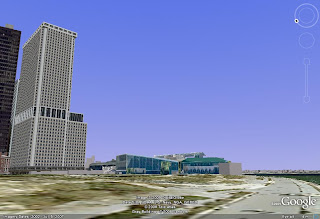Thus, audio driving tours are such a natural part of the placecasting concept. Here's a set of audio tours from my neck of the woods: the Mississippi River in Wisconsin. Thirty-three towns along the Wisconsin side of the river have banded together to create 33 podcasts about the environment and history in their area. They're calling the project Great River Road Stories and the site is full of other information about this beautiful stretch of country. (What's really impressive is that it looks like they created the audio tours 4 years ago, when podcasting was still very much in its infancy.)
View Larger Map
From Prescott to Keiler, the tours are 4-8 minute overviews of the history of each town the listener is about to pass through. Some towns have more interesting histories than others, of course, but by the end, a listener should have a good sense of what this landscape used to be like. I will definitely try to do this drive sometime this summer.
As I try to use my radio training to create this kind of place-based environmental journalism, I'm going to start collecting best (and worst) practices from the tours I hear. So, with all respect to the hard work of the team that put this impressive series together, here's my critique:
- Pro: While most of the tour is a narrator reading a script, the tour occasionally breaks up this monotony by cutting to local experts who talk about geology or history.
- Pro: The narrator gives clear but brief guidance about how to use the tour...in each case saying to pause the podcast until you've passed through the town just talked about
- Pro: There is a simple, unobtrusive music bed under all the sections. I think it's always the same music, which is too bad, but it adds energy and momentum to the items and makes them seem less like lectures
- Pro: There is a great diversity of information! History, environment and geology are all rolled in here and it's packed with facts and statistics.
- Pro: There are good human stories in many of the towns. Clearly, the writers made an effort to tell stories of particular events.
- Con: The narrator's pacing never changes. He doesn't pause when he switches topics from, say, history to geology. This leaves the listener no time to digest the points just made. A lot of the great facts and stats will never stay with a listener at a pace like this. The narrator uses no vocal tools to set off particular pieces of information. When everything has equal weight, everything becomes the lowest common denominator.
- Con: The script is not written for the ear. The narrator does a nice job navigating some long, clunky, passive sentences, but ultimately the script sounds like text lifted from a guidebook or museum display. Ears need short, active sentences written to paint pictures in the listeners' mind.
- Con: The script rarely references what the listener is actually seeing, or suggesting where to look when the listener gets to a particular location. This neglects one of the great advantages to this kind of journalism...you know where the consumer is and you can use that to enhance the story.
- Con: Too many numbers. It's hard to work numbers into a narrative. Distances, addresses, ages all need context for a listeners' brain to really understand what they mean. If that rock is 8-thousand years old, tell me why that's impressive. Don't tell me the address of the historical society...tell me where to turn when I drive through town. I'll be there shortly, after all.
No matter the technology, storytelling is key. These Great River Road Stories are a wonderful service to visitors and residents alike, and they're just a re-write away from really engaging listeners' imaginations and connecting them with the environment of this beautiful part of the country.
Link: Great River Road Stories audio tours






